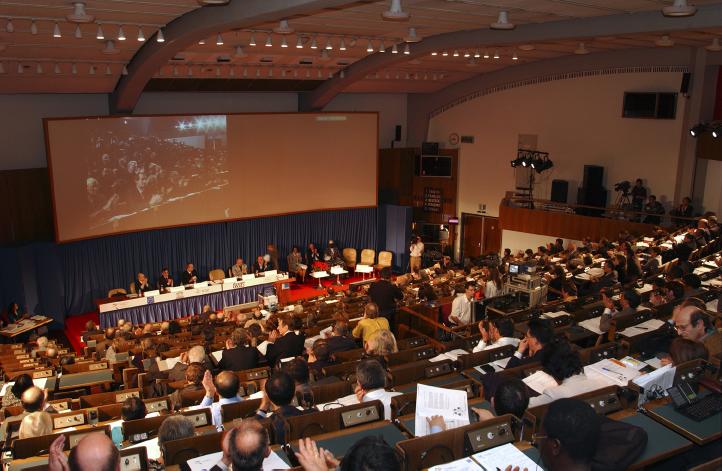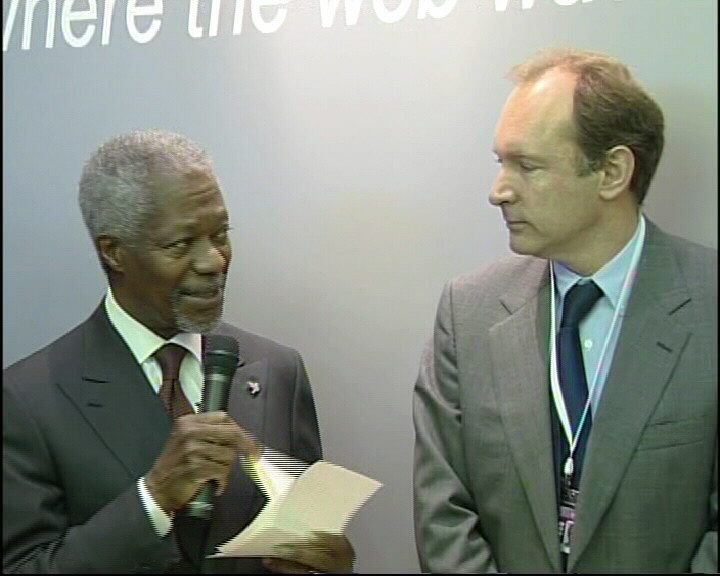|
 The
objective of Technology Transfer (TT) at CERN is “to
make known and available to third parties under agreed
conditions, technical developments achieved in fulfilling
the laboratory's mission in fundamental research”.
The IT Department contributes to this objective by
the transfer of technology, expertise and know-how to industry,
universities, public institutions and the society at large. The
objective of Technology Transfer (TT) at CERN is “to
make known and available to third parties under agreed
conditions, technical developments achieved in fulfilling
the laboratory's mission in fundamental research”.
The IT Department contributes to this objective by
the transfer of technology, expertise and know-how to industry,
universities, public institutions and the society at large.
IT Department activities focus on fast changing
Information and Communications Technologies (ICTs), which often require that
the necessary developments are conducted in collaboration with external
partners. As a result, the main channels for TT in the Department are
collaborations and partnering with external organizations, rather
than the classical patenting and licensing approach. The other main channel
for TT is the transfer of software technologies via collaboration
agreements or, more frequently, via open source mechanisms.
In IT, collaborations and partnering bring direct
additional funding (from funding agencies such as EC-funded projects, as
well as funding from industry such as the openlab). The open-source
approach for software also brings direct benefits by sharing and lowering
the cost of development and testing, as well as bringing indirect longer
term benefits, as exemplified by the World-Wide Web.
Technology Transfer through Software Licensing
In 2003, a study was undertaken within the Department to
review existing practices in terms of software licensing, to compare
licensing via bilateral agreements to that based on open source principles,
and to evaluate the various options for open source licensing (e.g. GPL,
LGPL, …).
Bilateral Collaboration Agreements may be
appropriate for only software developed within CERN. Open source is
appropriate in many cases, including, but not only, software developed in
collaboration with external partners. In 2003, two new software packages
were made available as open source (Print Server Software and SLIC), one new
bilateral Collaboration Agreement was signed (Friedrich Miescher Institute
for Biomedical Research) and a number of new organizations downloaded the
Printing Client Package (programs in binary-only format).
Technology Transfer through R&D collaborations with
industry
 The
openlab for DataGrid Applications - a framework for evaluating and
integrating cutting-edge technologies or services in partnership with
industry - is the main vehicle for IT Department R&D partnering with
industry. In 2003, two new partners (IBM and Oracle) were successful
incorporated, bringing to the number of sponsors to five (together with
Enterasys, HP and Intel). The
openlab for DataGrid Applications - a framework for evaluating and
integrating cutting-edge technologies or services in partnership with
industry - is the main vehicle for IT Department R&D partnering with
industry. In 2003, two new partners (IBM and Oracle) were successful
incorporated, bringing to the number of sponsors to five (together with
Enterasys, HP and Intel).
The IT Department hosted two meetings of the First
Tuesday Suisse Romande series at CERN.
Technology Transfer through European Union collaborative
projects
The European DataGrid (EDG) and DataTag, both EC-funded
projects, were, in 2003, the major examples of TT through publicly funded
projects. The European Grid Industry and Research Forum (IRF) -a framework
initiated by the European DataGrid project and joined by the CrossGrid
project- is the focal point of contact between research on Grid
technologies and the industrial and scientific world. At the end of 2003,
the IRF counted 287 members. 2003 was also the key year for the preparation
and successful submission of the EGEE (Enabling Grid for eScience in Europe)
project. EGEE aims to integrate current national, regional and thematic Grid
efforts, in order to create a seamless European Grid infrastructure for the
support of the European Research Area.
Technology Transfer through education, outreach and
dissemination
 CERN
organizes the CERN School of Computing (CSC) every year. The 26th
CSC took place in Krems an der Donau, Austria. 68 students of 25 different
nationalities (a new record for CSCs) and from 39 different institutes
attended the school. 73% of them were citizens of a CERN Member State. CERN
organizes the CERN School of Computing (CSC) every year. The 26th
CSC took place in Krems an der Donau, Austria. 68 students of 25 different
nationalities (a new record for CSCs) and from 39 different institutes
attended the school. 73% of them were citizens of a CERN Member State.
 For
the second year running, an examination was offered at the end of school.
60 students registered for the exam and 53 passed. Each successful
candidate received a formal credit certificate from CERN. In 2003, a
proposal was made to the European Commission for grants to assist students
with living and travel allowance and cover a fraction of the organization
costs. The proposal was accepted with a high mark and the contract was
signed at the end of 2003. For
the second year running, an examination was offered at the end of school.
60 students registered for the exam and 53 passed. Each successful
candidate received a formal credit certificate from CERN. In 2003, a
proposal was made to the European Commission for grants to assist students
with living and travel allowance and cover a fraction of the organization
costs. The proposal was accepted with a high mark and the contract was
signed at the end of 2003.
The IT department (via the EDG and
EGEE projects) was also one of the founding members and is still a major
contributor to the International School on Grid Computing, organized by the
Global Grid Forum. The GGF Grid school 2003 took place in Vico Equense,
Italy.
 IT
was the originator of the RSIS (Role of Science in the Information Society)
conference held at CERN in December 2003. IT
was the originator of the RSIS (Role of Science in the Information Society)
conference held at CERN in December 2003.
 IT
contributions included the responsibility for organizing the projects into
work packages and that of designing and implementing the SIS-forum, an
exhibition organized at Palexpo in the framework of the World Summit on
Information Society (WSIS). The organization included 32 people from four
divisions (ETT, EP, IT, HR). After a Call for Content, 42 projects from 32
organizations world-wide were selected. IT
contributions included the responsibility for organizing the projects into
work packages and that of designing and implementing the SIS-forum, an
exhibition organized at Palexpo in the framework of the World Summit on
Information Society (WSIS). The organization included 32 people from four
divisions (ETT, EP, IT, HR). After a Call for Content, 42 projects from 32
organizations world-wide were selected.
 The
culminating event was the inauguration in the presence of Mr. Kofi Annan,
United Nations Secretary General. The SIS-forum Web site (http://cern.ch/sis-forum)
received more than half a million visits during the month following the
event. The
culminating event was the inauguration in the presence of Mr. Kofi Annan,
United Nations Secretary General. The SIS-forum Web site (http://cern.ch/sis-forum)
received more than half a million visits during the month following the
event.
Other activities
The IT DTTO contributed to the work of the Technology
Transfer Advisory Board (TAB). Within IT, an inventory of external
collaborations was carried out and the results presented via a taxonomy of
activities. A web site presenting TT in the IT Department was created
(http://cern.ch/it-tt).
January 2004
For more, contact
François Fluckiger, Technology
Transfer Officer, IT Department
|

